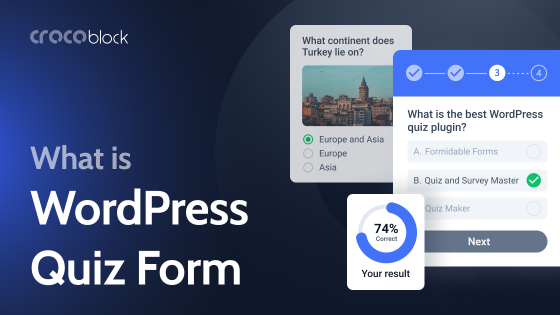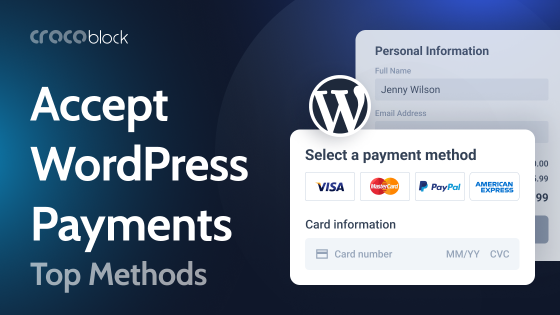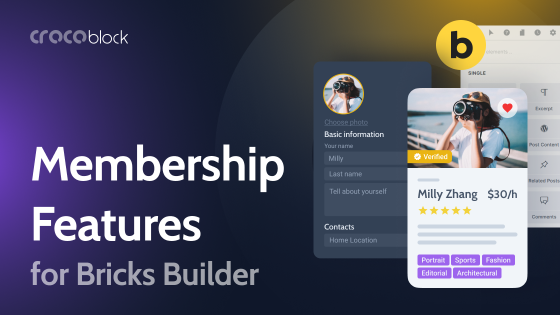Can we rely on ChatGPT as WordPress developers? Will it bring additional value? Will it make our lives better? These are really relevant questions. The answer is “Yes” if you know how to use it.
So, let’s get through a list of cases when AI can help you get things done faster and more efficiently.
Table of Contents
For much better results, assign roles to the ChatGPT in the particular chat. For example, “Imagine you are an experienced WordPress developer. From now on, you are answering like such a professional.”
Also, give clear instructions and examples, if needed.
Working With Code
Explaining code
It’s an extremely helpful functionality for WordPress developers of almost any level, especially those in the learning process. ChatGPT can be a really effective and free tutor. From template hierarchy to action hooks and filters, it can explain how different components interact with one another, enabling you to build robust and extensible solutions.
But for starters, it can explain the code syntax, purpose, and functionality of each line of code, helping you grasp how it fits into the larger context of your WordPress website.
Alternatively, it can add comments on your code so that later on, you will not forget what it does for your website. It is also able to write a docstring for you.
Just write “Explain the code,” paste the code you want to understand better and add extra context if needed.
Finding mistakes and optimizing code
Here are some examples of how ChatGPT can be useful for working with existing code:
- It can help you find syntax mistakes and explain why the code is not working.
- It can optimize and refactor it.
- ChatGPT will be useful for finding things like memory leaks in JavaScript.
- Another example is when you want to rewrite your code for another framework, let’s say, to switch from Vue to React. It will definitely save you a ton of time.
- It can give you test case examples for a particular piece of code.
As you can see, explaining and performing some debugging for your code is one of the most useful use cases of ChatGPT for you as a developer.
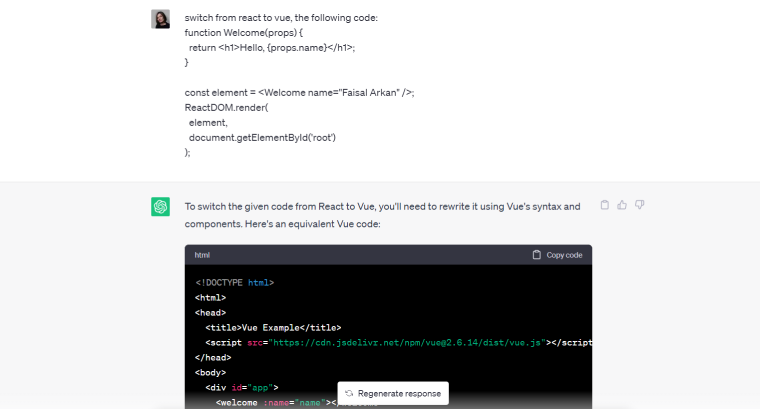
Code snippet generation
Save your time and let AI help you with the code, from simple HTML or CSS snippets to generating JavaScript libraries or some PHP. The main thing here is not to forget to code yourself, but I guess you will not because ChatGPT is not perfect, and your expertise is important for reviewing the results.
Even if you use tools like Elementor, with a lot of widgets, styling settings, and effects, often, it’s difficult to find exactly what you need, and a custom HTML, CSS, and JavaScript is the best solution.
For beginners
In this example, I asked ChatGPT to create an animated clipping path shaped by a speech bubble and the zoom-out effect. But I specified a clipping path, having previously created it using a generator. Without these details, the bot wasn’t able to make a proper speech bubble.
As you can see, even if the code is extremely basic, the chat still saved me time.
For advanced users
There are plenty of tasks you can give to ChatGPT as an experienced WordPress developer, from helping you to continue writing some code to assistance with parsing or working with various APIs.
Another example is creating SQL queries – this functionality is already integrated into the JetEngine plugin.
In case you want a better-trained model and coding is your main job, consider using something like GitHub Copilot, which is also based on OpenAI.
Writing a simple plugin
When the ChatGPT was just launched, the whole idea that it could perform such tasks shook the WordPress community. And here we are now; this idea doesn’t seem as wild as back then. Instead, you can benefit from it and create micro plugins that perform simple tasks. Will it be able to develop something complicated like Crocoblock? Absolutely not, but it can add some visual effects or custom messages.
Adding and updating Gutenberg blocks
ChatGPT can save you a lot of time and help create custom Gutenberg blocks. However, some expertise in plugin development and JavaScript is needed, and you will need to compile your code yourself.
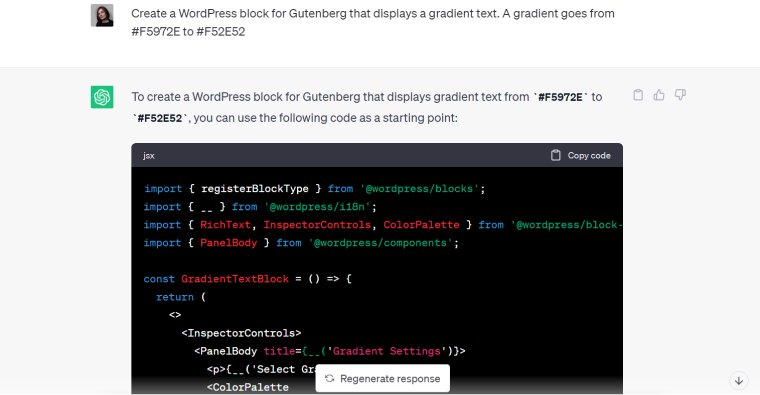
Design-Related Tasks
UX tips
Many WordPress developers create websites from scratch, and getting some UX tips would be quite useful. You can ask the chat about micro-interaction suggestions, gamification ideas, or ways to convey more clients.
The key here is to write a very clear and specific prompt that gives an idea of the project you design and the goals you want to achieve.
Prototyping tips
ChatGPT can help you to generate the structure of your future pages. Write a prompt describing the future page or a website, and ask it to give you the structure, with blocks and their description. Then, it can even offer you some instruments to use for building such pages.
Generating better labels and descriptions for plugin and theme UIs
If you are not an English native speaker, creating proper labels and descriptions for the parts of the plugins’ or themes’ UIs can be challenging. Here, ChatGPT can be really helpful and give variations for your draft labels. It will work much better if you describe the plugin/theme you want them to be generated for.
Writing prompts for Midjourney
A lot of Midjourney users confirm that ChatGPT creates great Midjourney prompts. But first, you should give a bot brief information about the Midjourney, as well as the prompting instructions from here and these style instructions.
Generating abstract SVG images
As a language model, ChatGPT can generate SVG images because they are basically a line of code. However, the quality of such “images” is bad, but such prompts can give you new ideas because the bot is really random. Also, you can use some elements as abstract shapes for some blocks or as patterns.
For example, the image below is what ChatGPT thinks are images inspired by Picasso, and the last one is what it considers to be a cat.

SEO-Related Tasks
Generating short descriptions for products
It’s not actually a developer’s task to generate product descriptions, but it certainly requires some automatization. That’s why you can connect OpenAI and use JetFormBuilder to add things automatically, and some fields will be filled by a content creator, while some will be generated automatically.
The grammar can be checked as well, and the post can be added to the website right away. It’s very easy to implement, and I’ve written how to do it in this article.
Generating SEO titles and descriptions
For better results, you can generate them manually by prompting ChatGPT about each article or use some automatization, as mentioned in the previous paragraph. However, I guess it’s easier with an AI-powered plugin that will do it for you.
Creating topic clustering
If you have a very popular article that brings many visitors to your site, you can ask ChatGPT to create a topic cluster based on it. Further on, creating such articles will help you to target the audience in a more precise way.

Things to Consider
It’s just important to mention that ChatGPT has limitations, especially if we consider that as web designers or developers, we are not making a “spherical cow” website but something very specific for the particular needs of our clients or our own projects.
That’s why many abstract ideas about how life-changing ChatGPT can be are not quite applicable. Yet, AI can answer your questions amazingly, especially if you write effective prompts.
Prompting tips
Good prompts are the key to great answers. That’s why it’s better to pay attention to some basic principles of creating them.
- Assign a role.
I really like how the results are getting better when you assign roles to the chatbot, something like “Give me answers as if you are a WordPress Guru” or “Give me answers as if you are a WordPress guru explaining things to a 7-grader.” You can experiment with such “assignation” prompts, e.g., there can be “Imagine you are …” or “You are …,” etc., and, depending on it, the tone of voice for the answers may vary.
- Use chain-prompting for complex tasks.
The idea is very simple: split a complex task into a few smaller ones, and you can refine and modify outputs after each step, so there’s a big chance to get more refined and precise results.
- One-shot prompting.
In simple terms, it means to give ChatGPT an example of an answer you want to receive so that it will generate a more precise result.
And if you are planning to use OpenAI models for your chatbot or, in some other way, connect it to the functionality of the website via API, it would be great to train the model. You would probably need some Python and JavaScript knowledge and get familiar with the LangChain framework and, of course, a lot of data to feed it.
FAQ
Definitely, yes. It can be used as a chat (see the tips in the article above), or you can connect your model to the site using API. Also, there are quite many plugins that already have AI functionality embedded in them.
Yes, all it takes is getting an automatization and form plugins, connecting to ChatGPT using its API code, and a few minutes of setting things up.
Takeaway
In this article, we talk about the technology that made the biggest buzz this year and became a real newsmaker – ChatGPT. It definitely can be helpful for you as a WordPress developer, designer, or content creator. So, I’ve broken down the ideas about how ChatGPT can save you a lot of time and improve your productivity and website quality according to these roles.
If you want to get more ideas about using not just ChatGPT but Open AI in general, check out these insights from our recent AI Summit.
